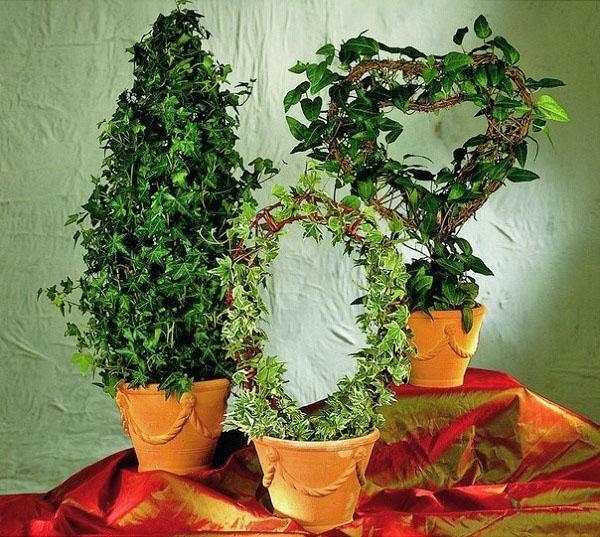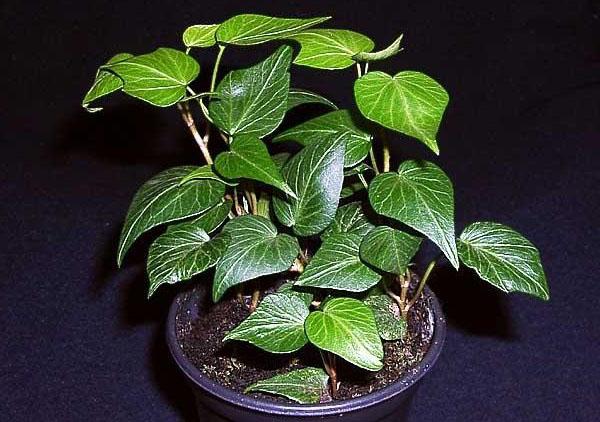Do you grow indoor ivy?
 Ivy are creeping stems with aerial roots. Indoor ivy in the presence of supports in the form of stretched ropes, sticks can create vertical gardening of the wall, or twine around a vertical pole. As a house plant, ivy absorbs harmful emissions and negative energy.
Ivy are creeping stems with aerial roots. Indoor ivy in the presence of supports in the form of stretched ropes, sticks can create vertical gardening of the wall, or twine around a vertical pole. As a house plant, ivy absorbs harmful emissions and negative energy.
Home care for indoor ivy

- correct lighting;
- temperature regime in summer and winter;
- watering, feeding and microclimate;
- transplant.
Ivy loves uniform illumination with indirect rays. In good light, the leaves grow actively and delight with a healthy look. If the flower is in the shade, it is depressed. In winter, the plant needs backlight.
Summer temperatures of 25 degrees for indoor ivy are considered comfortable. It can be arranged in the warm season on an open veranda or balcony. The place should be shady, preferably the western wall. Winter maintenance in room conditions is permissible, but only with regular spraying. The classic resting temperature of ivy is 13-15 degrees, which is impossible in room conditions.
The plant loves fresh air, frequent ventilation, it is not afraid of a draft. But blowing with air currents with sub-zero temperatures should be avoided.
Indoor ivy is a medicinal plant. The nutrients it contains have many beneficial properties. The alcoholic extract from the berries is used to get rid of warts. The infusion of the leaves is used for joint pain, cough, and heals wounds.
Indoor ivy flower is watered abundantly in summer, less than half in winter. The plant loves to be washed under a warm shower, sprayed. During the period of active growth, they feed complex fertilizers for decorative deciduous flowers.
 Young plants are transplanted annually into potting soil for flower crops. If the substrate is prepared on its own, take in equal proportions of humus leaf and sod earth, sand. The grounds for transplanting or transshipment are signs:
Young plants are transplanted annually into potting soil for flower crops. If the substrate is prepared on its own, take in equal proportions of humus leaf and sod earth, sand. The grounds for transplanting or transshipment are signs:
- small growth of branches;
- a lump of earth is completely entangled with roots;
- leaves wither.
Ivy is transplanted in the spring. The pot is taken larger than the previous one, a layer of drainage is laid, cut sphagnum is poured on top, a little earth. Using the transshipment method, they arrange a flower in a pot, pour earth on the sides with compaction. The neck should remain at the same level. After the ivy has been planted, it needs to create favorable conditions for the development of roots. The flower tolerates such transshipment painlessly.
Plant diseases and pests
 Ivy is resistant to infectious diseases and rot. If his leaves begin to turn yellow, then you need to reduce watering. The tips of the leaves dry out - the air in the room is dry. If the leaves have become smaller, you need to add lighting.
Ivy is resistant to infectious diseases and rot. If his leaves begin to turn yellow, then you need to reduce watering. The tips of the leaves dry out - the air in the room is dry. If the leaves have become smaller, you need to add lighting.
Pests settle on the plant in case of insufficient care. If the leaves turn yellow and curl, look for aphids. You can get rid of it by treating the leaves with a high concentration soap solution or insecticides.
Spider mite determined by punctures of leaves and a cobweb on the back.Later, the sheet will dry out unless urgent action is taken. The plant will be saved by three-time treatment of the plant with a systemic insecticide and frequent spraying.
Yellow thrips will show themselves as brown spots on the back. The face of the sheet will be white. If left untreated, the sheets will dry out and fall off. You need a solution of pyrethrum at a concentration of 2 g per liter of water. Treat twice after 10 days.
The mealybug, scale insect and false scale are harmful to the plant. Any insect will weaken the plant and deprive it of its decorative effect.
Reproduction of indoor ivy
 The vegetative way of reproduction is mainly used. Most often, reproduction is carried out by cuttings. Cuttings can be taken apical and middle. The upper shoots cut off during the formation of the lash are rooted about three in a glass with a diameter of 7 cm, in the ground in half with sand. If there are aerial roots, then the stalk acquires vitality faster. The middle cuttings of 8 sheets are laid horizontally in the soil, deepened by indentation and wait for the roots to appear. After 10 days, real roots are obtained from the aerial roots. The shoot is cut and each part is rooted separately. Cuttings treated with rootstock root better.
The vegetative way of reproduction is mainly used. Most often, reproduction is carried out by cuttings. Cuttings can be taken apical and middle. The upper shoots cut off during the formation of the lash are rooted about three in a glass with a diameter of 7 cm, in the ground in half with sand. If there are aerial roots, then the stalk acquires vitality faster. The middle cuttings of 8 sheets are laid horizontally in the soil, deepened by indentation and wait for the roots to appear. After 10 days, real roots are obtained from the aerial roots. The shoot is cut and each part is rooted separately. Cuttings treated with rootstock root better.
You can get layering from a branch of indoor ivy on a bush. To do this, the twig is attached to the ground with the bark incised from below. If you bent a long stem, you need to pin several knots. Roots will appear in the places of wounds, it remains to divide the layers into fragments and put them in a permanent place.
 The question of how to grow ivy from seeds rarely arises. At home, it is rarely possible to achieve flowering of the plant, and the seeds in the berries are undeveloped. Therefore, you can buy seeds, but without varietal characteristics. It is difficult for seeds to germinate, since in nature they are first processed in bird stomachs. Experienced flower growers advise to soak the seeds for a day in a solution of "Fairy", and then the same amount in a growth stimulator.
The question of how to grow ivy from seeds rarely arises. At home, it is rarely possible to achieve flowering of the plant, and the seeds in the berries are undeveloped. Therefore, you can buy seeds, but without varietal characteristics. It is difficult for seeds to germinate, since in nature they are first processed in bird stomachs. Experienced flower growers advise to soak the seeds for a day in a solution of "Fairy", and then the same amount in a growth stimulator.
The soil consists of sand and earth, sowing is shallow. To preserve moisture, the bowl should be covered with glass and placed in the light. Seedlings should appear in 2 weeks. When a real leaf appears, the plants need to be cut down. Young seedlings grow quickly.
Ivy myths and reality
 People believe that all living things, including plants, can give or take energy. Ivy is believed to be an energy vampire. Some are convinced that it takes energy, others - gives vitality. You can use the point of view of psychoanalysts. They assume that the plant, along with toxic secretions from furniture, tobacco smoke, absorbs aggressive bursts of energy. That is why it is advised to grow ivy in a room where hyperactive children live. The plant will cleanse the apartment from the unkind energy of the uninvited guest.
People believe that all living things, including plants, can give or take energy. Ivy is believed to be an energy vampire. Some are convinced that it takes energy, others - gives vitality. You can use the point of view of psychoanalysts. They assume that the plant, along with toxic secretions from furniture, tobacco smoke, absorbs aggressive bursts of energy. That is why it is advised to grow ivy in a room where hyperactive children live. The plant will cleanse the apartment from the unkind energy of the uninvited guest.
MYTH! Ivy for Christians is a symbol of eternal life, fidelity. The religious emblem is a pillar covered with ivy like a cloak.
Ignoring the signs, is it possible to keep indoor ivy at home? They say that the plant "muzhegon" squeezes men out of the apartment. How many families fall apart without ivy? The ancient Romans believed that ivy would assist a girl in a successful marriage.
The reality is that the indoor ivy flower is unpretentious, purifies the air, and is not even afraid of drafts. In addition, ivy is a good natural healer and a poisonous plant.
I found albino ivy! It is completely white, it grows in the shady garden of my friends. I would like to plant his stalk in a pot and keep it at home as a houseplant. Do you think garden ivy can grow at home?
Thank!
You can try, for example, common garden ivy is successfully grown both in the open field and in indoor conditions.